

Thursday November 06, 2003
CARTRIX WRC
HYUNDAI ACCENT RALLY
By Rob Wessling
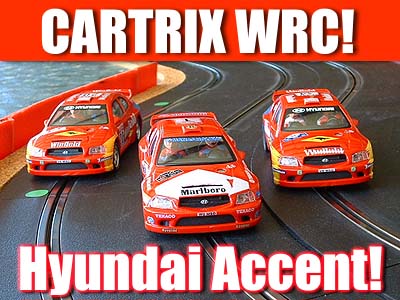 As
a recent arrival to Millennium Raceway, I was very keen to give the CARTRIX WRC
Hyundai Accent Rally model a ''workout'' around our 17.5 meter Scalextric Sport
four-lane layout. I found it a very pleasurable experience, and thought I'd
share my findings with you.
As
a recent arrival to Millennium Raceway, I was very keen to give the CARTRIX WRC
Hyundai Accent Rally model a ''workout'' around our 17.5 meter Scalextric Sport
four-lane layout. I found it a very pleasurable experience, and thought I'd
share my findings with you.
The specific model for this test is the CARTRIX (REF- No. 306R) WRC Hyundai Accent Rally car, Winfield sponsorship, driven by M.Guest, (Co-driver D.Green) during the San Remo rally. The livery chosen for this model is very handsome (to my eyes at least). A red base color with blue and yellow ''flashes'' on each corner of the car certainly make for maximum ''eye appeal''. I must admit to being drawn to this particular model by way of it's ''Aussie'' flavor, with the primary sponsor, ''Winfield'' being a prominent Australian tobacco company. It's great for an Aussie like me to see our local icon, ''Skippy'' the Kangaroo, proudly displayed on the front bonnet and flanks of the WRC Hyundai rally. The ''local connection'' doesn't stop there however, with both Driver and Co-driver being Aussies! I also gained a great deal of pleasure seeing our Nation's flag being displayed in miniature next to the Driver and Co-drivers name, it is something that doesn't occur too often in our hobby!
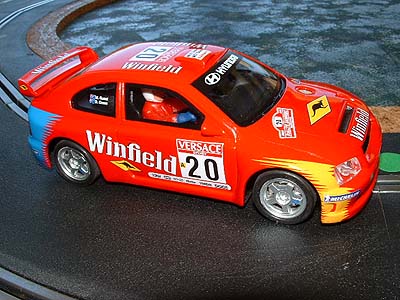 I'd
like to take this opportunity to note for those of you that don't like seeing
tobacco advertising in motor-sport (1:1 or scale racing), that CARTRIX have also
included REF-No. 305R WRC Hyundai Accent Finland 2000 in their current
catalogue. The car features the same stunning livery, substituting ''No-name''
signage for the ''Winfield'' logo. Other variations to the model on test are
limited to a different competition number and style of wheel, both models are
mechanically identical. Initial inspection reveals the fit and finish of this
model to be well above average. The body of the Hyundai Rally is virtually
identical to that used for the CARTRIX Maxi-Tuning (the rally version has a
cabin ventilation scoop attached to the roof). As with the previous
Maxi-Tuning, the rally version also displays very crisp panel lines as part of
the overall body molding. Rear view mirrors are an integral part of the body
molding, perhaps not as detailed in this respect as other offerings on the
market, but I can personally attest to their long-term durability!
I'd
like to take this opportunity to note for those of you that don't like seeing
tobacco advertising in motor-sport (1:1 or scale racing), that CARTRIX have also
included REF-No. 305R WRC Hyundai Accent Finland 2000 in their current
catalogue. The car features the same stunning livery, substituting ''No-name''
signage for the ''Winfield'' logo. Other variations to the model on test are
limited to a different competition number and style of wheel, both models are
mechanically identical. Initial inspection reveals the fit and finish of this
model to be well above average. The body of the Hyundai Rally is virtually
identical to that used for the CARTRIX Maxi-Tuning (the rally version has a
cabin ventilation scoop attached to the roof). As with the previous
Maxi-Tuning, the rally version also displays very crisp panel lines as part of
the overall body molding. Rear view mirrors are an integral part of the body
molding, perhaps not as detailed in this respect as other offerings on the
market, but I can personally attest to their long-term durability!
The Tampo printing on my review model is first rate, exhibiting a high level of detail. The application is top quality, with only a small over run being noticeable on one of the side ''Winfield'' logos. Apart from this very insignificant flaw, the only real fault I could find in the overall finish of the exterior were several small dust particles trapped in the clear coat on the front bonnet. I, like many other enthusiasts like my 1/32 models to be as perfectly executed as possible, it is most unfortunate that this minor blemish detracted from an otherwise excellently finished exterior.
Having said this, I ask readers to please view this personal observation in the appropriate context. I have cars in my small collection that have cost more than twice the price of this model, with exactly the same (minor) flaws. At the end of the day we must realize that most models of interest to the average 1/32 scale enthusiast are mass produced, and as such it is virtually impossible for manufacturers to produce a ''perfectly'' finished model every time.
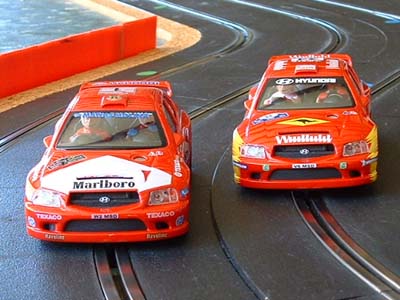
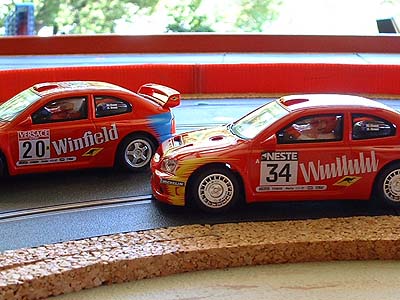
Moving on to other items of interest regarding model detail, we find the inclusion of some finely detailed five spoke OZ racing wheels on the CARTRIX WRC Rally 4X4. These are backed up by ventilated disc brakes, which add enormously to the eye appeal of this model. Topping off the wheel and tire package for this model are a set of CARTRIX treaded tires measuring 19X9.6 front and 20X10.5 rear. The wider rear tires fill out the rear wheel arches quite nicely, giving the model an aggressive stance.
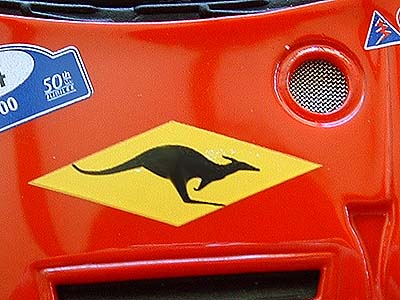
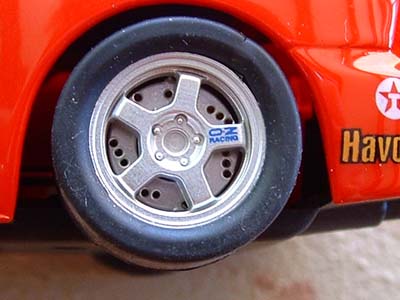
The radiator and intercooler openings on the CARTRIX WRC Rally are fitted with molded black plastic grilles, a departure from the ''Maxi-Tuning'', which had metal mesh type grilles. I actually prefer the molded black plastic grilles on this model, as the detail is finer. Very fine ribs in the intercooler opening and a silver painted Hyundai logo really add to the overall quality of detailing for this model. I would also like to point out that the natty little round ''turbo'' cooling vent that we saw on the bonnet of the ''Maxi-Tuning'' bonnet is still present on this Hyundai, featuring the same fine steel mesh.
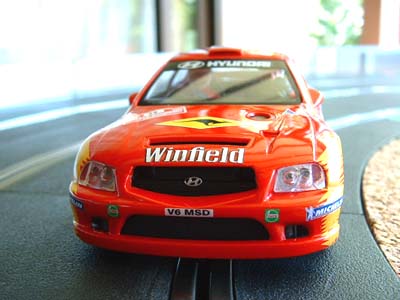
Interior detail is confined to the inclusion of a half tray interior, which includes a spare tire, dash, steering wheel and two driver figures. The navigator is ''clutching'' a notes board (must be my wife driving this stage!), both figures featuring open face helmets, a neat detail item is the inclusion of black painted intercom microphones for the crew, very nice indeed. Another item of interest that I noted when viewing the interior is the inclusion by CARTRIX of black painted window surrounds to the ''glass'' of this model. It's something that I didn't pick up on first inspection of the Hyundai Accent WRC, small details like this definitely add to the overall sharpness of a 1/32 model! If I were to choose one word to describe the overall appearance of the CARTRIX WRC Rally, it would be CRISP!
Time now to see what makes this CARTRIX ''tick''. After removing the body screws (two front, one rear) I immediately noticed the inclusion of some unique features on this model. The first items I noticed were two red (more pink actually!) springs on the underside of the body. These springs slip over two posts (one post located either side of the body underside, approximately in-line with the centre line of each wheel arch when viewed from side on).
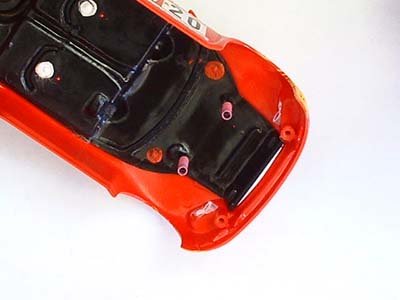
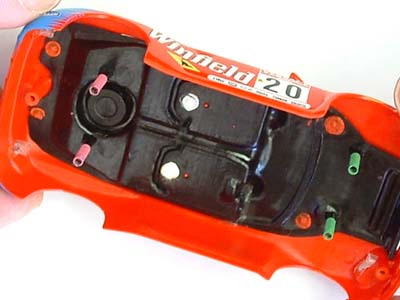
Two posts are also located in the same position over the rear axle, but no springs were present on them. The spring base sits neatly on the top of each corner's brass axle bushing when assembled correctly. Please note, the easiest way of re-attaching the body with ''suspension'' springs in place is to hold the body upside down in one hand, place springs on each post, then carefully place the chassis (topside first!) onto the body. Then it's simply, tighten screws to desired tension and you're in business! I'll cover the ''suspension'' aspect of this model in more depth, a little later in the review.
Another innovative of the CARTRIX Hyundai WRC is the style of front guide suspension it utilizes. The guide itself is equipped with single braids, with a simple guide spring return system as found in the CARTRIX ''Maxi-Tuning''. The main difference to the ''Maxi-Tuning'' is the inclusion of a plastic extension piece that sits atop the standard guide. The extension has a ''blade'' on the bottom of the extension that dovetails into the top of the standard guide assembly and a groove on the top of the assembly for the return spring to run through. This extension is held in place by way of return spring tension. Although a seemingly ''makeshift'' arrangement, it does provide adequate guide travel as well as proving quite robust during extensive testing on our circuit.
The CARTRIX Hyundai WRC is otherwise similar in mechanical configuration to many other 1/32 4X4 rally cars currently on the market. The motor is an in-line mid engine set-up, driving both axles via solid drive shafts. Gearing consists of 8 tooth brass pinions and a 25 tooth plastic spur gear for both axles. The axles are quality steel, proving to be quite true in dimension and straightness. Brass bushings provide the support for both axles, inspection indicated a snug fit for all four bearings when mated to their respective axles. One point I'd like to raise about the bushing to chassis fit (by way of standard molded plastic chassis clips), is the way the front bushings fit into the front chassis clips. When I initially checked the tolerances for the front bushings in relation to chassis clips, I found a large amount of movement (I am not kidding). Immediately concerned at this apparent manufacturing flaw, I quickly checked the rear chassis bushing clips, upon close inspection I found that the situation IS the way the factory meant things to be! The rear clips provide good, tight contact with the bushings (as we like to see). The front clips are intentionally loose to provide the front axle with a degree of vertical travel. The ''neck '' portion of the front clips hold the bushings in place however, so there shouldn't be any concerns regarding ''wayward'' front axle assemblies during use. Still not sure about the front set up, I checked the front axle spur to pinion mesh (I was concerned about ''live'' axles flopping about the place). The mesh of the front gears proved to be ideal, with very little sideways (lateral) play. After looking at it, I honestly don't believe that this set-up will affect the long term durability and performance of the model, as the movement present rotates around the axis line of the drive shaft (sort of like walking up stairs). I believe the pitch of the gears on this model isn't fine enough to cause any problems in this regard.
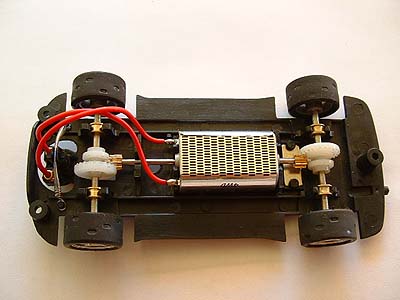
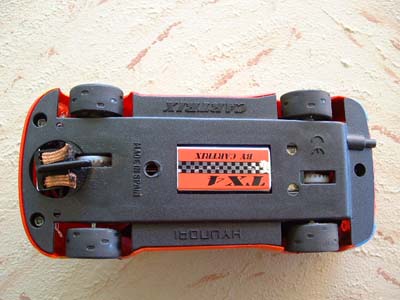
Ok, down to the ''good bits'', the motor and magnet combination! The magnet is the CARTRIX Neo bar unit (REF- 1113), measuring 16X6X3mm, similar in overall dimensions and performance to the FLY B73 magnet. It is mounted between the motor and rear axle, which is a great location for it. The motor is the CARTRIX TX4, offering 20,000 RPM at 15 volts and 330 G/cm of torque (200MA). By way of comparison, the ''Maxi-Tuning'' was equipped with the CARTRIX TX2.3, 21,500 RPM and 310 G/cm of torque, drawing 190MA. Going by these figures we can expect a difference of 20 G/cm more torque and 1500 less revs with the TX4. More torque should equate to better acceleration and fewer revs should equate to lower top end speed. Time now to see how the CARTRIX Hyundai performs on the track.
Mum always said that the proof of the pudding was in it's eating! Well, let me assure you that this test was a feast! As is my usual procedure when testing, I like to put a model on the track in stock out of the box condition and run a few laps to see how it goes. I do this mainly for those of us that don't get too involved in the tuning side of our hobby (I can understand why, tuning can become a tedious and time consuming chore at times. Most of us just want to have fun with our hobby, something I'm all for!).
Our layout is a Scalextric Sport four lane circuit, average lane length is 17.5 meters, power supply is by way of four standard Scalextric wall type power supplies (wall warts). For this test I used our new Professor Motor ''silver series'' home racing controller, a very nice change from our original Scalextric 60 Ohm handsets (and Parma 15 ohm Turbo)!
After running a couple of ten lap brackets around Millennium Raceway, I managed to produce a best lap of 5.9 seconds from the CARTRIX Hyundai WRC in stock out of the box condition. A most impressive time for a 4WD rally car around our circuit, this betters times produced by our Ninco 4WD Subaru by over 1.5 seconds!
I consider anything that can break into the ''5's'' on our circuit a quick model. Another comparison can be drawn by times achieved with a stock Scalextric Sport MG Lola, this model is pretty much accepted as one of the quicker models currently on the market. Our stock standard Scalextric Sport MG produces best lap times of approximately 5.7 seconds. As can be seen, this little Hyundai is running with some ''fast company''.
After this first run it was time for a little tuning. Front and rear gear-sets were run in with ''turtle wax'' car polish, cleaned and re-greased. Motor bushings were oiled lightly at the same time. Wheels were chucked in the Dremel and gently sanded to ensure concentricity. Tires were also lightly buffed at this time to remove a slight amount of molding flash that was found to be present. I would like to add that both wheels and tires are on this model were found to be quite true for normal hobby use, I perform this task on all models I tune as a matter of course. Rear axle bushings were then glued into the chassis clips (note rear only!). Final preparations included gluing the motor to the chassis and wheels onto axles with Superglue.
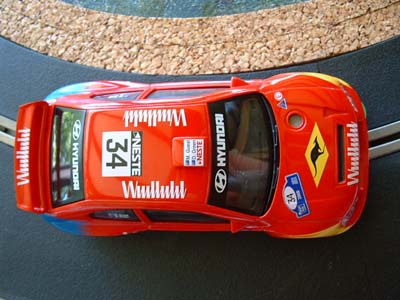 After
completing these tasks I ran the Hyundai WRC for a few more ten-lap brackets,
achieving a best time of 5.8 seconds. Not a great gain in overall lap times by
any means, but the car did run significantly quieter and smoother. Handling of
the chassis was quite predictable, being easy to punt around the track and
having great acceleration out of the corners. The TX4 motor is a very sweet
choice for this style of car, giving excellent throttle response, combined with
sharp braking characteristics. The added friction of the 4WD layout also
accentuates this effect to some degree, I found that I could nearly halve the
braking distances into corners that I normally use for various 2WD models. I
think that CARTRIX has done an admirable job in combining a good balance of
acceleration and braking with the Hyundai WRC, something that is sure to endear
this model to many 1/32 scale rally enthusiasts.
After
completing these tasks I ran the Hyundai WRC for a few more ten-lap brackets,
achieving a best time of 5.8 seconds. Not a great gain in overall lap times by
any means, but the car did run significantly quieter and smoother. Handling of
the chassis was quite predictable, being easy to punt around the track and
having great acceleration out of the corners. The TX4 motor is a very sweet
choice for this style of car, giving excellent throttle response, combined with
sharp braking characteristics. The added friction of the 4WD layout also
accentuates this effect to some degree, I found that I could nearly halve the
braking distances into corners that I normally use for various 2WD models. I
think that CARTRIX has done an admirable job in combining a good balance of
acceleration and braking with the Hyundai WRC, something that is sure to endear
this model to many 1/32 scale rally enthusiasts.
Is this the end of the review? No, not by any means, you should know by now that I try to gain every last fraction of performance from my models! I decided to try a tire change with the Hyundai WRC to see if I could gain some more performance from it. As noted earlier in the review, this model comes with different sized front and rear tires. Whilst in a rear wheel drive car this would be of no concern, in a 4WD car a difference in overall tire diameters will also result in a difference of overall gearing between front and rear axles. To me, this doesn't seem to be the ideal situation, as in this case the front axle should theoretically turn more than the rear axle. Which means either the front wheels are spinning at some point or the friction caused by this imbalance is manifesting itself somewhere in the driveline. For my money I'd lay a bet it would be in the motor, checking this, I found that the motor was indeed warmer to the touch than would otherwise be considered normal. In cases similar to the one described, I would always recommend checking the gearing of both sets of drive wheels by using the MM per Rev formula I have mentioned previously at HRW. Therefore using the formula:-
No. of pinion teeth X 3.141 X Tire Diameter divided by No. of spur teeth = MM per Revolution.
We find the front wheels run at 19.09 MM per rev, whilst the rears run at 20.30 MM per rev. I would consider this to be a moderate variance in overall gearing. I can understand why CARTRIX have used larger diameter tires on the rear axle however. As with many products within our hobby, they can be focused more toward aesthetic presentation than function. The wheel arches of the Hyundai WRC are quite large and do go begging for some wider rubber to make for a model with a more aggressive ''stance''. I would however like to see CARTRIX add a second set of tires when packaging the Hyundai WRC, which match dimensions of the front ones for those of us intending to get the most from our models (whether it be Home Racing or club competition).
After exchanging the rear tires for a set from my spares box that match the models front tire dimensions and tread style, it was time to hit the track for some laps (N.B. replacement rears were buffed prior to running on the track). After several ten-lap sessions, I found that lap times had dropped to 5.4 seconds. I considered this a worthwhile performance gain for the effort involved. On track impressions of the car were quite favorable, I was really warming to this little 4WD ''beastie''.
A new day and a few more ideas came about, after a good track clean I ran some more laps with the Hyundai WRC to ''calibrate'' for later testing. We had some very nasty windstorms over the previous 24 hours locally, and I wanted to keep the track as clean as possible. I found that this alone helped the model to better lap times, posting a best of 5.2 seconds after the previous evenings best of 5.4 seconds.
Next on the agenda was the substitution of the stock factory treaded tires for a set of 4 ''buffed'' CARTRIX 19X9MM special racing slicks. I had used these tires before during testing the CARTRIX ''Maxi-Tuning'' and found them to be ideally suited to our Scalextric Sport layout. Testing once again verified this for me, with the Hyundai WRC rocketing around our layout in a best time of 4.8 seconds! Now this was some 4WD sled, exhibiting that nice stuck down magnet traction feel! Levels of grip were exceptional, especially considering the torque of the TX4 motor and the low overall gearing (19.09MM per Rev versus approx. 22 MM per rev for many models in our small ''fleet''). Punch out of corners was terrific, braking excellent, yet the whole package was quite predictable on the ''edge''. Mind you when this baby lets go it's in a quite spectacular manner! This model is quite at home running around lane 2 of our layout in the 5.0 second range, simply stunning performance.
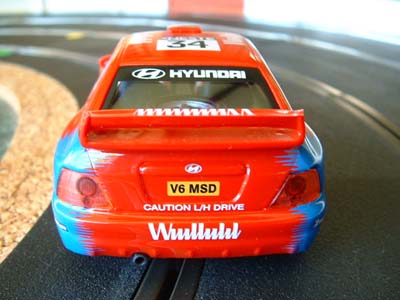 Having
a few spare minutes and needing an excuse to run a few more laps with this
little gem, I decided to have a mess around with the ''suspension'' system on
the model to see how and IF it worked. As mentioned previously, the Hyundai WRC
comes with two red (hard) springs attached to posts situated over the front
bushings. From the factory, the Hyundai is set up with the front body screws
screwed up firmly. I ran quite a few laps changing the ''tension'' of the front
body screws, from dead tight to one turn loose. I couldn't see any tangible
difference in performance by doing this, the lap timer verified my thoughts.
Having
a few spare minutes and needing an excuse to run a few more laps with this
little gem, I decided to have a mess around with the ''suspension'' system on
the model to see how and IF it worked. As mentioned previously, the Hyundai WRC
comes with two red (hard) springs attached to posts situated over the front
bushings. From the factory, the Hyundai is set up with the front body screws
screwed up firmly. I ran quite a few laps changing the ''tension'' of the front
body screws, from dead tight to one turn loose. I couldn't see any tangible
difference in performance by doing this, the lap timer verified my thoughts.
Changing tact, I rummaged through the spares box once again and came out with a full set of CARTRIX suspension springs (REF-1008). I put the red (hard) set on the rear posts and a set of green (soft) springs on the front posts. To begin with, adjusting body tension had little effect (think of all the hours/combinations you could come up with doing this!!!). I finally came across the following setting, back body screw backed off 1/2 turn, front body screws backed off a quarter turn. This setting felt really nice, it would still step out under hard acceleration, but the car seemed to carry more speed through the corners. The lap counter showed a best lap of 4.7 seconds a few times, perhaps a minor improvement? The jury is still out on this, but I honestly believe there could be some merit in this system. Time will tell though, when I get some more spare time I'll explore this suspension system a little more.
Wow, what a ''journey'' I've had with the CARTRIX Hyundai WRC 4X4 Rally. I've learnt a great deal and enjoyed the whole time I've spent reviewing this model! This IS the fastest model currently in our ''slot garage'', shading it's sibling, the CARTRIX ''Maxi-Tuning'' by a mere 1/10th of a second around our layout. Time wise the difference is insignificant, but considering the Hyundai WRC Rally is carrying around the extra weight and friction associated with a 4X4 layout, it is a fantastic effort!
In conclusion, I find that the CARTRIX Hyundai WRC 4X4 Rally to be an exceptionally beautiful 1/32 slot car. This model combines its striking on track appearance with quality components, which combine to provide the 1/32 Rally enthusiast with breathtaking levels of performance.
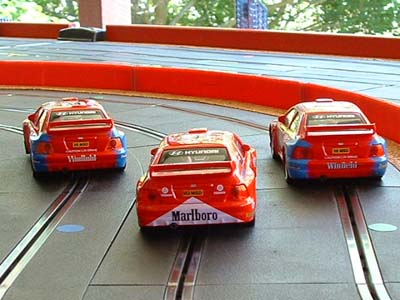 I
did not test the CARTRIX Hyundai WRC without its magnet, primarily because we
enjoy running magnet cars on our layout. I'm sure that this model will acquit
itself just as well in non-mag competition, having a wonderfully designed and
balanced chassis.
I
did not test the CARTRIX Hyundai WRC without its magnet, primarily because we
enjoy running magnet cars on our layout. I'm sure that this model will acquit
itself just as well in non-mag competition, having a wonderfully designed and
balanced chassis.
This model does have some very minor flaws, but considering the overall quality and performance of the CARTRIX Hyundai WRC, I can quite easily forgive the manufacturer in this instance!
CARTRIX is to be highly commended for providing 1/32 slot enthusiasts with such an excellent model, THANK YOU CARTRIX!
- Rob
Thanks go to CARTRIX for providing these models for review!
Don't forget to visit Rob's site! We thank him for his contribution and effort!